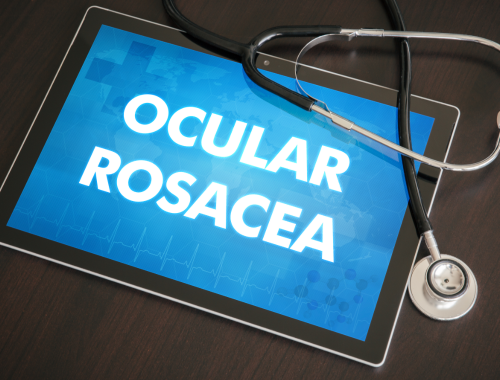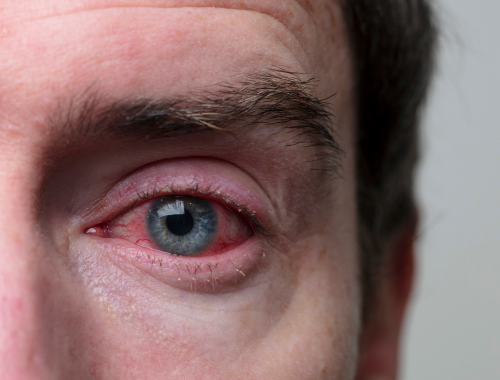Difference Between Ocular Rosacea and Blepharitis
Ocular rosacea is a chronic inflammatory disease of the eyes and the skin adjacent to it. It is the most severe form of blepharitis, that has no cure. Blepharitis is the inflammation of the eyelids, caused by irritation of the eyelid lining and clogging of the oil glands in the eyelid.

What is ocular rosacea?
Definition:
Ocular rosacea is a chronic inflammatory disease of the eyes and the skin adjacent to it. It is the most severe form of blepharitis, that has no cure.
Causes:
The exact causes of ocular rosacea are yet to be discovered. A few speculated reasons for having the condition include bacterial infections like helicobacter pylori gastritis, genetic causes, environmental irritants, exposure to UV light, stress, and living in extremes of hot or cold climates.
Symptoms:
Symptoms of ocular rosacea include swollen edematous eyelids, puffy edematous eyes, red eyes, bloodshot eyes, extreme dryness, itching and burning sensation in the eyes, watery eyes, crusty eyelashes, and recurrent styes or chalazion.
Risk factors:
Ocular rosacea tends to affect adults less than 50 years old, females, light-skinned people, and people of Western European descent.
Diagnosis:
There are no specific tests to diagnose ocular rosacea. Detailed history and physical examination are pivotal in diagnosing the condition.
Treatment:
Knowing and avoiding the triggers is the best way to prevent ocular rosacea. Other treatment options are the use of warm compresses on eyes after bathing, using antibiotics like doxycycline, use of eye drops to avoid drying of eyes, and wearing sunscreen.

What is blepharitis?
Definition:
Blepharitis is the inflammation of the eyelids, caused by irritation of the eyelid lining and clogging of the oil glands in the eyelid.
Causes:
Blepharitis is caused mainly by meibomian gland dysfunction, which is the oil-producing gland for tears. Acne rosacea, allergies, seborrheic dermatitis, dry eyes, and mites in eyelashes are the most common causes of blepharitis.
Symptoms:
Symptoms of blepharitis are swollen edematous, greasy eyelids, red eyes that are itchy, dry eyes, crusted eyelashes, sticky eyes, repetitive blinking, photophobia, flaky skin around the eyelids, blurring of vision and eyelashes growing towards the eyes (trichiasis).
Risk factors:
Risk factors for developing blepharitis are diabetes, chronic exposure to dust, living in dry weather, wearing contact lenses frequently, having oily skin, not removing makeup thoroughly, menopausal women, and those on cancer therapy.
Diagnosis:
Diagnosis of blepharitis is made after taking a just, doing an external eyelid examination, and taking a culture of eye discharge. A tear test can be done to identify dry eyes. An eyelash exam under the microscope is done to detect mites. Only rarely an eyelid biopsy is taken if skin cancer is suspected.
Treatment:
At-home measures to reduce blepharitis include avoiding eye makeup, using warm compresses to clean the eyelid, and using lid scrubs to reduce dandruff on the lashes. A healthcare provider will identify the cause of blepharitis and may prescribe antibiotics ointments like erythromycin, or bacitracin in case of bacterial infections and steroid eye drops or cream in case of inflammatory causes.
Difference between ocular rosacea and blepharitis
Definition:
Ocular rosacea is a chronic inflammatory disease of the eyes and the skin adjacent to it. It is the most severe form of blepharitis, that has no cure. Blepharitis is the inflammation of the eyelids, caused by irritation of the eyelid lining and clogging of the oil glands in the eyelid.
Causes:
The exact causes of ocular rosacea are yet to be discovered. A few speculated reasons for having the condition include bacterial infections like helicobacter pylori gastritis, genetic causes, environmental irritants, exposure to UV light, stress, and living in extremes of hot or cold climates. Blepharitis is caused mainly by meibomian gland dysfunction, which is the oil-producing gland for tears. Acne rosacea, allergies, seborrheic dermatitis, dry eyes, and mites in eyelashes are the most common causes of blepharitis.
Symptoms:
Symptoms of ocular rosacea include swollen edematous eyelids, puffy edematous eyes, red eyes, bloodshot eyes, extreme dryness, itching and burning sensation in the eyes, watery eyes, crusty eyelashes, and recurrent styes or chalazion.
Symptoms of blepharitis are swollen edematous, greasy eyelids, red eyes that are itchy, dry eyes, crusted eyelashes, sticky eyes, repetitive blinking, photophobia, flaky skin around the eyelids, blurring of vision and eyelashes growing towards the eyes (trichiasis).
Risk factors:
Ocular rosacea tends to affect adults less than 50 years old, females, light-skinned people, and people of Western European descent. Risk factors for developing blepharitis are diabetes, chronic exposure to dust, living in dry weather, wearing contact lenses frequently, having oily skin, not removing makeup thoroughly, menopausal women, and cancer therapy.
Diagnosis:
There are no specific tests to diagnose ocular rosacea. Detailed history and physical examination are pivotal in diagnosing the condition. Diagnosis of blepharitis is made after taking a just, doing an external eyelid examination, and taking a culture of eye discharge. A tear test can be done to identify dry eyes. An eyelash exam under the microscope is done to detect mites. Only rarely an eyelid biopsy is taken if skin cancer is suspected.
Treatment:
Knowing and avoiding the triggers is the best way to prevent ocular rosacea. Other treatment options are the use of warm compresses on eyes after bathing, using antibiotics like doxycycline, use of eye drops to avoid drying of eyes, and wearing sunscreen. At-home measures to reduce blepharitis include avoiding eye makeup, using warm compresses to clean the eyelid, and using lid scrubs to reduce dandruff on the lashes. A healthcare provider will identify the cause of blepharitis and may prescribe antibiotics ointments like erythromycin, or bacitracin in case of bacterial infections and steroid eye drops or cream in case of inflammatory causes.
Table of differences between ocular rosacea and Blepharitis

FAQs
Is blepharitis the same as ocular rosacea?
Ocular rosacea is the most severe form of blepharitis, that has no cure.
How do you clean eyelids with ocular rosacea?
Gentle cleaning with a warm cloth is encouraged.
What triggers ocular rosacea?
A few speculated reasons for having the condition include bacterial infections like helicobacter pylori gastritis, genetic causes, environmental irritants, exposure to UV light, stress, and living in extremes of hot or cold climates.
What is the best treatment for ocular rosacea?
Knowing and avoiding the triggers is the best way to prevent ocular rosacea.
Can an optometrist treat ocular rosacea?
Yes.
Should you see an ophthalmologist for ocular rosacea?
Yes.
- Difference Between Ocular Rosacea and Blepharitis - September 22, 2023
- Difference Between Toxic and Nontoxic Goiter - August 18, 2023
- Difference Between Anterolisthesis and Retrolisthesis - July 31, 2023
Search DifferenceBetween.net :
Leave a Response
References :
[0]Bernardes, Taliana Freitas, and Adriana Alvim Bonfioli. "Blepharitis." Seminars in ophthalmology. Vol. 25. No. 3. Taylor & Francis, 2010.
[1]McCulley, James P., and Ward E. Shine. "Changing concepts in the diagnosis and management of blepharitis." Cornea 19.5 (2000): 650-658.
[2]Vieira, Ana Carolina Cabreira, Ana Luisa Höfling-Lima, and Mark J. Mannis. "Ocular rosacea: a review." Arquivos brasileiros de oftalmologia 75 (2012): 363-369.
